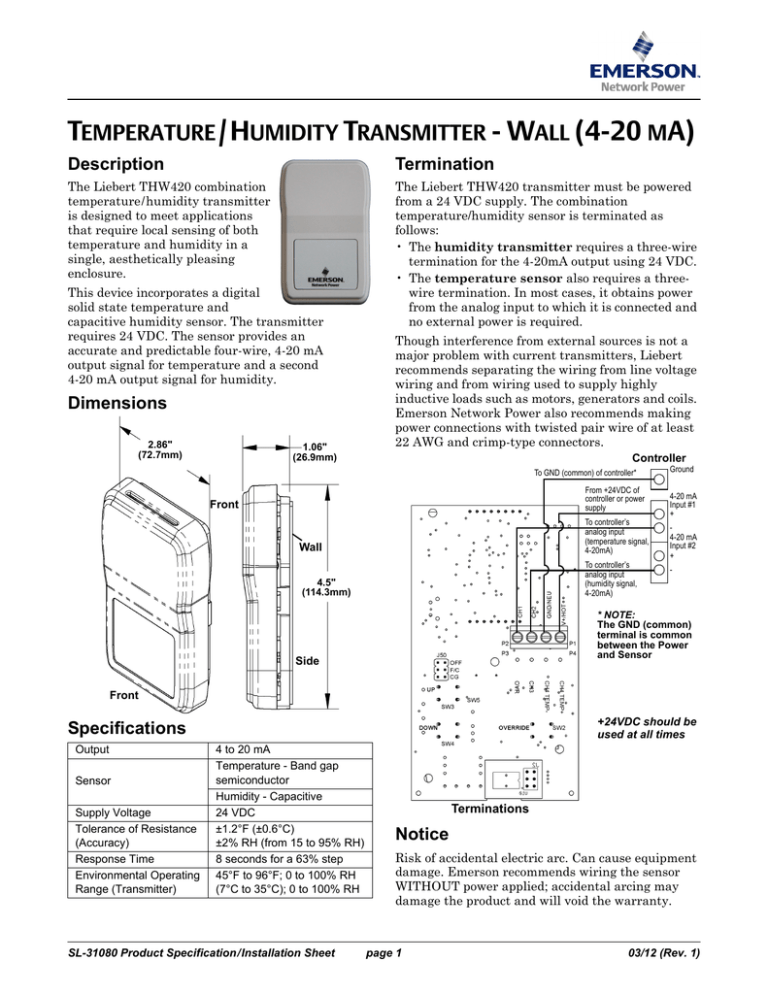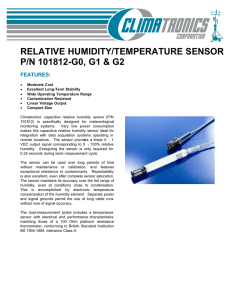T /H - W (4-20
advertisement

TEMPERATURE /HUMIDITY TRANSMITTER - WALL (4-20 MA) Description Termination The Liebert THW420 combination temperature/humidity transmitter is designed to meet applications that require local sensing of both temperature and humidity in a single, aesthetically pleasing enclosure. The Liebert THW420 transmitter must be powered from a 24 VDC supply. The combination temperature/humidity sensor is terminated as follows: • The humidity transmitter requires a three-wire termination for the 4-20mA output using 24 VDC. • The temperature sensor also requires a threewire termination. In most cases, it obtains power from the analog input to which it is connected and no external power is required. This device incorporates a digital solid state temperature and capacitive humidity sensor. The transmitter requires 24 VDC. The sensor provides an accurate and predictable four-wire, 4-20 mA output signal for temperature and a second 4-20 mA output signal for humidity. Dimensions 2.86" (72.7mm) 1.06" (26.9mm) Though interference from external sources is not a major problem with current transmitters, Liebert recommends separating the wiring from line voltage wiring and from wiring used to supply highly inductive loads such as motors, generators and coils. Emerson Network Power also recommends making power connections with twisted pair wire of at least 22 AWG and crimp-type connectors. Controller To GND (common) of controller* From +24VDC of controller or power supply Front To controller’s analog input (temperature signal, 4-20mA) Wall To controller’s analog input (humidity signal, 4-20mA) 4.5" (114.3mm) Ground 4-20 mA Input #1 + 4-20 mA Input #2 + - * NOTE: The GND (common) terminal is common between the Power and Sensor Side Front +24VDC should be used at all times Specifications Output Sensor Supply Voltage Tolerance of Resistance (Accuracy) Response Time Environmental Operating Range (Transmitter) 4 to 20 mA Temperature - Band gap semiconductor Humidity - Capacitive 24 VDC ±1.2°F (±0.6°C) ±2% RH (from 15 to 95% RH) 8 seconds for a 63% step 45°F to 96°F; 0 to 100% RH (7°C to 35°C); 0 to 100% RH SL-31080 Product Specification/Installation Sheet Terminations Notice Risk of accidental electric arc. Can cause equipment damage. Emerson recommends wiring the sensor WITHOUT power applied; accidental arcing may damage the product and will void the warranty. page 1 03/12 (Rev. 1) Enclosure Mounting Instructions Ordering Information Qty Part # THW420 Mounting hardware is provided for both junction box and drywall installation. Description Combination Temperature/Humidity Transmitter Wall 4-20 mA @ 45°F to 96°F and 0 to 100% RH 1. Pull the wires through the opening in the base plate. Mounting 2. For junction box installation: Secure the base to the box using the #6-32 x 1/2" mounting screws provided. Wall For drywall installation: Drill two 3/16" holes 3-1/4" apart on center. Insert the drywall anchors and secure the base using the #6 x 1" sheet metal screws provided. Junction box 2" x 4" 3. Terminate the unit according to the guidelines in Termination on page 1. 4. Attach the cover by latching it to the top of the base, rotating the cover down and snapping it into place. 5. Secure the cover by backing out the lock-down screws using a 1/16" allen wrench until they are flush with the bottom of the cover. Troubleshooting - Humidity Signal Verification, 4 to 20 mA Signal Mounting screws Cover Locking Screws 1/16" Allen NOTE In a wall-mount application, the wall temperature and the temperature of the air within the wall cavity can cause erroneous readings. The mixing of room air and air from within the wall cavity can lead to condensation and premature failure of the sensor. To prevent these conditions, seal the conduit leading to the junction box and seal the hole in the drywall by using an adhesive backed, foam insulating pad. You will measure the humidity output by placing an ammeter in series with the controller input. The controller input is connected to the terminal marked “Ch1 or Ch2” on the humidity board. 1. Verify the unit is terminated properly using Figure 4 shown below, and set your meter to the “Volts” setting. 2. Verify you have 24 VDC supplied to the unit by measuring between the “V+” and “GND” terminals at the sensor, as shown below in Figure 3. 3. Set your meter to “Amps” and measure the output between “Ch1 or Ch2” and the controller input as shown below in Figure 3. 4. Use the following formula to determine what humidity the sensor is reading: (mA - 4) / 0.16 = %RH where mA is the current reading from the ammeter (in mA) Example: If the current reading is 16 mA, then: %RH = (16 - 4) / 0.16 = 12 / 0.16 = 75% SL-31080 Product Specification/Installation Sheet page 2 03/12 (Rev. 1) Figure 1 Supply Voltage and 4-20mA Verification GND(-) Figure 2 4 to 20 mA Output Connection GND(-) GND(-) POWER SUPPLY CONTROLLER + V+ + V V+ A - GND(-) POWER SUPPLY Analog Input CONTROLLER V+ Analog Input - Ch1 or Ch2 V+ ROOM SENSOR Ch1 or Ch2 ROOM SENSOR Troubleshooting Guide The following table lists common problems and possible solutions. For more information, consult your local dealer, Liebert representative or the Liebert Worldwide Support Group. Problems Possible Solutions Unit will not operate • Check +24 VDC power supply at controller. • Disconnect the sensor and check power wires for +24 VDC. Humidity reading is maximum 20 mA or 100% • Make sure the sensor is wired properly. Humidity reading is minimum 4 mA or 0% • Verify that the humidity sensor is wired properly. Humidity reading in software appears to be off more than specified accuracy • Check all software parameters. • If available, check the sensor against a calibrated control such as a hygrometer. • Determine if the sensor is exposed to an external source more than room. Temperature sensor in frontend software is reading high • Make sure wiring is correct. • Disconnect wires and measure with a multimeter. Temperature sensor in frontend software is reading low • Make sure wiring is correct. • Disconnect wires and measure with a multimeter. SL-31080 Product Specification/Installation Sheet page 3 03/12 (Rev. 1) Troubleshooting - Humidity Signal Verification 4 to 20 mA Signal You will measure the humidity output by placing an ammeter in series with the controller input. The controller input is connected to the terminal marked “Ch1 or Ch2” on the humidity board. 1. Verify the unit is terminated properly using Figure 4 shown below, and set your meter to the “Volts” setting. 2. Verify you have 24 VDC supplied to the unit by measuring between the “V+” and “GND” terminals at the sensor, as shown below in Figure 3. 3. Set your meter to “Amps” and measure the output between “Ch1 or Ch2” and the controller input as shown below in Figure 3. 4. Use the following formula to determine what humidity the sensor is reading: (mA - 4) / 0.16 = %RH where mA is the current reading from the ammeter (in mA) Example: If the current reading is 16 mA, then: %RH = (16 - 4) / 0.16 = 12 / 0.16 = 75% Figure 3 Supply Voltage and 4-20mA Verification GND(-) Figure 4 4 to 20 mA Output Connection GND(-) POWER SUPPLY CONTROLLER + V+ + V+ V A - GND(-) GND(-) POWER SUPPLY Analog Input CONTROLLER V+ Analog Input - Ch1 or Ch2 V+ ROOM SENSOR SL-31080 Product Specification/Installation Sheet Ch1 or Ch2 ROOM SENSOR page 4 03/12 (Rev. 1)





